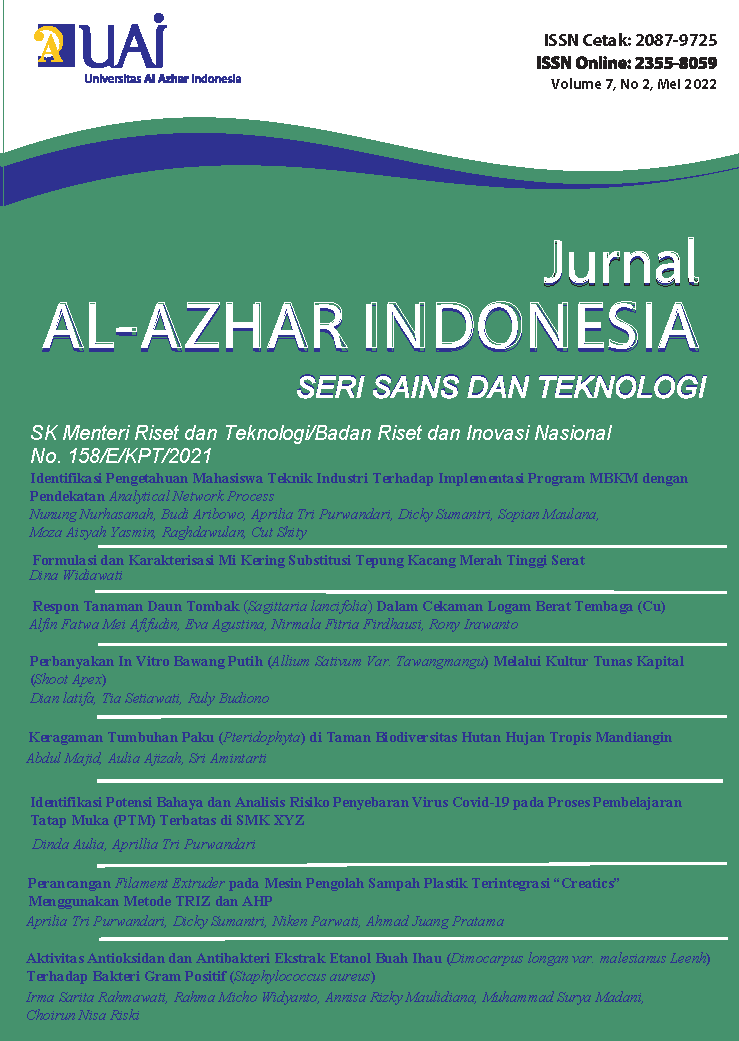Respon Tanaman Daun Tombak (Sagittaria lancifolia) Dalam Cekaman Logam Berat Tembaga (Cu)
DOI:
https://doi.org/10.36722/sst.v7i2.1118Abstract
One type of heavy metal that pollutes waters is heavy metal copper (Cu). Cu metal is basically an essential metal for living things, but with high levels of Cu metal, it can interfere with the body's metabolic processes. Therefore, there needs to be a solution to overcome Cu metal pollution in the waters. One of them is phytoremediation, or the use of plants to absorb pollutants. Spear leaf plant (Sagittaria lancifolia) is proven to be able to absorb heavy metal copper (Cu). However, the growth response is not yet known in more detail. Therefore, this study aimed to determine the growth response of pike leaf (Sagitaria lancifolia) under stress of heavy metal copper (Cu). This research is an experimental study with a completely randomized design (CRD). The experiment was conducted with 8 treatments (4 treatments with 2 tests) and 3 replications. The 4 treatments were distinguished based on differences in the concentration of Cu metal used, namely 0 mg/L, 1mg/L, 2mg/L, and 3 mg/L. The results showed that exposure to heavy metal copper (Cu) in each concentration variation and detention time variation did not have a significant effect on the growth and morphological conditions of spear leaf (Sagittaria lancifolia) plant, so this plant deserves to be used as an option in recovery efforts of water environment contaminated with heavy metal copper (Cu).
Keywords – Response, Lanceleaf arrowhead, Sagittaria lancifolia, Heavy metals, Copper (Cu)
References
A. F. Afifudin and R. Irawanto, “Estimating The Ability of Lanceleaf Arrowhead (Sagittaria lancifolia) in Phytoremediation of Heavy Metal Copper (Cu),†Berk. SAINSTEK, vol. 9, no. 3, pp. 125–130, Aug. 2021, doi: 10.19184/BST.V9I3.26667.
S. A. Zubayr, “Analisis Status Pencemaran Logam Berat di Wilayah Pesisir (Studi Kasus Pembuangan Limbah Cair dan Tailing Padat/Slag Pertambangan Nikel Pomalaa),†IPB (Bogor Agricultural University), Bogor, 2009.
R. A. A. I. . P. F. A. Filipus, “Bioakumulasi Logam Berat Tembaga Cu Pada Kerang Darah Di Perairan Muara Sungai Lumpur Kabupaten Ogan Komering Ilir Sumatera Selatan,†Maspari J, vol. 10, no. 2, pp. 131–140, 2018.
A. Rukmi, “Analisis Kandungan Logam Berat Tembaga (Cu) Pada Tiram Bakau (Crassostrea Cucullata) Dan Air Di Pesisir Paciran, Kabupaten Lamongan, Jawa Timur,†Universitas Brawijaya, Malang, 2019.
D. Yunasfi and K. P. Singh, “The heavy metal of cuprum (Cu) and lead(Pb) content in Avicennia marina and Rhizophora mucranata The heavy metal of cuprum (Cu) and lead(Pb) content in Avicennia marina and Rhizophora mucranata,†IOP Conf. Ser. Earth Environ. Sci., vol. 374, no. 1, Nov.doi: 10.1088/1755-1315/374/1/012064. 2019.
N. Sekarwati, “Dampak Logam Berat Cu (Tembaga) dan Ag (Perak) pada Limbah Cair Industri Perak Terhadap Kualitas Air Sumur dan Kesehatan Masyarakat serta Upaya Pengendaliannya di Kota Gede Yogyakarta,†UNS Sebelas Maret, Surakarta, 2014.
M. Siotto and R. Squitti, “Copper imbalance in alzheimer’s disease: Overview of the exchangeable copper component in plasma and the intriguing role albumin plays,†Coord. Chem. Rev, vol. 37, no. 1, pp. 86–95, 2018.
S. Fitria, “Potensi Tanaman Genjer (Limnocharis Flava) Untuk Mengurangi Kadar Logam Berat (Pb Dan Cu) Serta Radionuklida Dengan Metode Fitoremediasi,†Universitas Brawijaya, Malang, 2014.
K. H. D. Tang, S. H. Awa, and T. Hadibarata, “Phytoremediation of Copper-Contaminated Water with Pistia stratiotes in Surface and Distilled Water,†Water. Air. Soil Pollut., vol. 231, no. 12, doi: 10.1007/s11270-020-04937-9. 2020.
D. Lu, Q. Huang, C. Deng, and Y. Zheng, “Phytoremediation of Copper Pollution by EightAquatic Plants,†Polish J. Environ. Stud., vol. 27, no. 1, pp. 175–181, Jan. 2018, doi: 10.15244/PJOES/73990. 2018.
N. Hidayati, Tanaman Akumulator Merkuri (Hg), Timbal (Pb), dan Kadmium (Cd) untuk Fitoremediasi, no. Cd. 2020.
A. Taufiqr, A. R. Asri, and Joko Purnomo, “Penanggulangan Klorosis pada Kacang Tanah di Alfisol Alkalis,†Bul. Brawijaya, vol. 3, no. 1, pp. 1–16, 2008.
M. Firmansyah and M. Alfarisi, “Uji Patogenisitas Patogen Hawar Daun Pada Tanaman Kayu Afrika (Maesopsis Eminii Engl.) Di Persemaian Permanen BPDAS Bogor,†J. Silvikultur Trop., vol. 7, no. 2, pp. 115–124, 2016.
A. Fatoni, “Fitoremediasi Logam Berat (Zn) Menggunakan Tanaman Eceng Gondok (Eichhornia crassipes,†UIN Sunan Ampel, Surabaya, 2020.
S. Estuningsih, J. Juswardi, B. Yudono, and R. Yulianti, “Potensi tanaman rumput sebagai agen fitoremediasi tanah terkontaminasi limbah minyak bumi,†2013.
S. Guzel and R. Terzi, “Exogenous hydrogen peroxide increases dry matter production, mineral content and level of osmotic solutes in young maize leaves and alleviates deleterious effects of copper stress,†Bot. Stud., vol. 54, no. 1, Aug. doi: 10.1186/1999-3110-54-26. 2013
Ardiansyah, “Aplikasi Kombinasi Limbah Cair Industri Tempe Dan Urea Pada Pertumbuhan Dan Hasil Selada (Lactuca Sativa),†FP UMY, Yogyakarta, 2016.
C. Ross and F. S. Garden, Plant Physiology, 1947-1972. 1974.
W. Larcher, Physiological plant ecology: ecophysiology and stress physiology of functional groups. 2003.
B. nurdin. “Antipasi Perubahan Iklim untuk Keberlanjutan Ketahanan Pangan,†J. Dialog Kebijak. Publik, vol. 4, no. 1, 2011.
A. Verma and S. Bhatia, “Analysis of some physicochemical parameters and trace metal concentration present in the soil around the area of Pariccha thermal power station in Jhansi, India,†Int. J. Innov. Sci. Eng., vol. 3, pp. 10482–10488, 2014.
P. M. G. Nair, I. M. Chung, “Study on the correlation between copper oxide nanoparticles induced growth suppression and enhanced lignification in Indian mustard (Brassica juncea L.),†Ecotoxicol. Environ. Saf., vol. 113, pp. 302–313. doi: 10.1016/J.ECOENV.2014.12.013. 2015.
A. Sağlam, F. Yetişsin, M. Demiralay, and R. Terzi, “Copper Stress and Responses in Plants,†Plant Met. Interact. Emerg. Remediat. Tech., pp. 21–40, Jan. doi: 10.1016/B978-0-12-803158-2.00002-3. 2016.
C. W. Lee, M. B. Jackson, M. E. Duysen, T. P. Freeman, and J. R. Self, “Induced Micronutrient Toxicity in ‘Touchdown’ Kentucky Bluegrass,†Crop Sci., vol. 36, no. 3, pp. 705–712. doi: 10.2135/CROPSCI1996.0011183X003600030031X. May 1996.
W. Maksymiec, “Effect of copper on cellular processes in higher plants,†Photosynth. 1997 343, vol. 34, no. 3, pp. 321–34. doi: 10.1023/A:1006818815528. Jan 1998.
H. Panou-Filotheou and A. M. Bosabalidis, “Root structural aspects associated with copper toxicity in oregano (Origanum vulgare subsp. hirtum),†Plant Sci., vol. 166, no. 6, pp. 1497–1504. doi: 10.1016/J.PLANTSCI.2004.01.026. Jun 2004.

